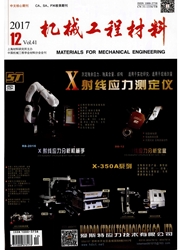

 中文摘要:
中文摘要:
通过显微组织分析和力学性能测试对退火处理后等径角轧制AZ31镁合金板材进行了研究,在试验条件下,退火处理后板材中原有的非基面晶粒取向未发生明显改变;随着退火时间的延长,退火温度的升高,晶粒逐渐趋于均匀、等轴化并发生长大,孪晶消失,抗拉强度和屈服强度逐渐降低,断裂伸长率明显提高,各向异性减弱。这表明,孪晶的存在及晶粒粗化导致板材的塑性降低,而非基面晶粒取向和均匀等轴化的晶粒组织则有利于其塑性的提高,明显的屈服现象、低的屈服强度和大的应变硬化现象可归因于板材内(0002)基面晶粒取向的减弱。
 英文摘要:
英文摘要:
Microstructure and properties of AZ31 magnesium alloy sheet processed by equal channel angular rolling(EACE) and then annealing treated were investigated. The results show that the initial non-basal plane orientation is not changed obviously after annealing treatment at the experimental conditions. With increasing of annealing time and temperature, the homogeneous and equiaxed grains begin to form and grow up and twins disappears gradually. At the same time, the strength decreases with improving the ductility and the anisotropy is weakened. These show that the existence of twins and coarsened grains can reduce the ductility and non-basal plane orientation and refined grains are in favor of the ductility. The clearly yield phenomenon, lower yield strength and larger strain hardening is due to weakening of the (0002) basal plane grain orientation.
 同期刊论文项目
同期刊论文项目
 同项目期刊论文
同项目期刊论文
 Drawability of AZ31 magnesium alloy sheet produced by equal channel angular rolling at room temperat
Drawability of AZ31 magnesium alloy sheet produced by equal channel angular rolling at room temperat Effect of channel clearance on crystal orientation development in AZ31 magnesium alloy sheet produce
Effect of channel clearance on crystal orientation development in AZ31 magnesium alloy sheet produce Effect of equal-channel angular rolling pass on microstructure and properties of magnesium alloy she
Effect of equal-channel angular rolling pass on microstructure and properties of magnesium alloy she Improvement of drawability at room temperature in AZ31 magnesium alloy sheets processed by equal cha
Improvement of drawability at room temperature in AZ31 magnesium alloy sheets processed by equal cha 期刊信息
期刊信息
